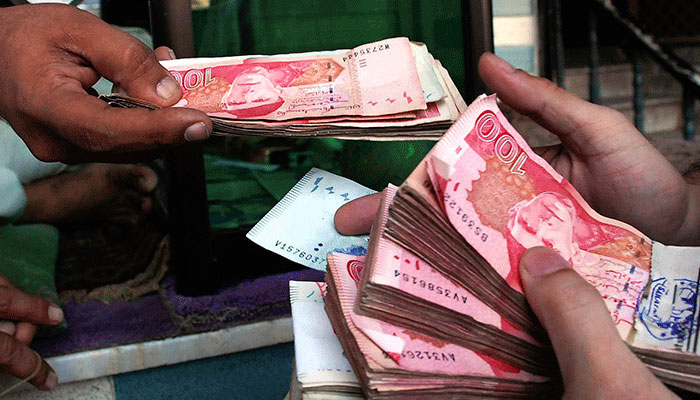Rupee hits all-time low; looks vulnerable
The rupee ended at 168.94 to the dollar in the interbank market
KARACHI: The rupee skidded to an all-time low on Tuesday as importers scrambled to buy dollars, with the currency looking increasingly vulnerable to a swelling current account deficit.
A rising food import bill and slowing export growth have heightened the risk on the rupee and the outlook remains bearish.
The rupee ended at 168.94 to the dollar in the interbank market, 0.50 percent or 84 paisas weaker than Monday’s close of 168.10. The previous all-time low was 168.43 in August 2020, according to central bank data.
At its recod low, the rupee has slumped 7 percent so far this fiscal year.
The rupee dropped to near an all-time low of 169.60 against the dollar in the kerb market, Exchange Companies Association of Pakistan data showed. A previous record low of 169.80 was set in August last year.
“The supplies (of dollars) were inadequate because of the weight of demand for dollars from importers,” said a dealer at one commercial bank. “Any comfort for the rupee was not seen given the central bank’s market-based exchange range regime, where the market forces determine the currency’s moves.”
Analysts said the sharp increase in imports is driven by higher international commodity prices, especially oil and robust domestic demand.
“Imports crossed $6 billion mark for the second time in last three months and remained above the $5 billion mark for the last six months, due to uptick in economic activity amid higher commodity prices has put pressure on rupee as the SBP (State Bank of Pakistan) is using it as the first line of defense,” said analyst Muhammad Awais Ashraf at Foundation Securities.
“Skyrocketed freight charges have further aggravated the situation as the freight charges for imports from Shanghai to Karachi have crossed $9,000 mark,” he added.
Concerns over a swell in the country’s import bill have flared since the global commodity prices are surging. Businesses are also expected to make imports of raw material and capital goods to establish new factories and expand existing plants under the State Bank’s Temporary Economic Refinance Facility this fiscal year. This puts pressure on the local unit.
The trade deficit soared 133 percent year-on-year to $4.05 billion alone in August. It jumped 114 percent to $7.32 billion in the first two months of the current fiscal year. Imports rose 89.9 percent to $6.31 billion in August, while exports increased 42.5 percent to $2.25 billion.
Analyst Faisal Mamsa at Tresmark said the central bank is using a loose monetary policy to ensure liquidity and growth but at the expense of a weaker currency.
“However, traders are looking at the central bank for direction and lack of a strong anchor from SBP will cause the rupee to keep depreciating and further an atmosphere of lingering uncertainty, posing risks to an already fragile state of recovery," Mamsa said. "Covid inflation is a big concern in economies across the globe. But higher structural inflation vis-à-vis the US will continue to pressure the rupee.”
Some analysts, apart from domestic factors, see the regime change in Afghanistan weighs on the rupee as well.
“The extra pressure on the rupee is due to the Afghanistan factor and the rupee remained under stress since the Taliban took control in Afghanistan and withdrawal the US forces from the country,” said Khurram Schehzad, CEO of Alpha Beta Core.
There is an outflow of dollars to Afghanistan because of the scarcity of the US currency amid dried foreign aid after the Taliban set up a government in the country.
Traders and the analysts are monitoring how the rupee could stabilise in the near term.
Some see a hike in interest rates, measures to limit luxury imports, and market interventions to prevent the currency from further slide, and steps to discourage the build-up of imported inflation.
-
 Queen Camilla Supports Charity's Work On Cancer With Latest Visit
Queen Camilla Supports Charity's Work On Cancer With Latest Visit -
 Dove Cameron Opens Up About Her Latest Gig Alongside Avan Jogia
Dove Cameron Opens Up About Her Latest Gig Alongside Avan Jogia -
 Petition Against Blake Lively PGA Letter Gains Traction After Texts With Taylor Swift Revealed
Petition Against Blake Lively PGA Letter Gains Traction After Texts With Taylor Swift Revealed -
 Netflix Revises Warner Bros. Deal To $83 Billion: All-cash Offer
Netflix Revises Warner Bros. Deal To $83 Billion: All-cash Offer -
 Prince Harry Mentions Ex-girlfriend Chelsy Davy In UK Court
Prince Harry Mentions Ex-girlfriend Chelsy Davy In UK Court -
 David, Victoria Beckham 'quietly' Consulting Advisers After Brooklyn Remarks: 'Weighing Every Move'
David, Victoria Beckham 'quietly' Consulting Advisers After Brooklyn Remarks: 'Weighing Every Move' -
 Meta's New AI Team Delivered First Key Models
Meta's New AI Team Delivered First Key Models -
 Prince Harry Defends Friends In London Court
Prince Harry Defends Friends In London Court -
 AI May Replace Researchers Before Engineers Or Sales
AI May Replace Researchers Before Engineers Or Sales -
 Christina Haack Goes On Romantic Getaway: See With Whom
Christina Haack Goes On Romantic Getaway: See With Whom -
 Consumers Spend More On AI And Utility Apps Than Mobile Games: Report
Consumers Spend More On AI And Utility Apps Than Mobile Games: Report -
 Aircraft Tragedy: Missing Tourist Helicopter Found Near Japan Volcano Crater
Aircraft Tragedy: Missing Tourist Helicopter Found Near Japan Volcano Crater -
 Taylor Swift Lands In Trouble After Blake Lively Texts Unsealed
Taylor Swift Lands In Trouble After Blake Lively Texts Unsealed -
 'Prince Harry Sees A Lot Of Himself In Brooklyn Beckham'
'Prince Harry Sees A Lot Of Himself In Brooklyn Beckham' -
 Kate Middleton’s Cancer Journey Strengthens Her Commitment To Helping Children
Kate Middleton’s Cancer Journey Strengthens Her Commitment To Helping Children -
 Gaten Matarazzo Compares 'Stranger Things' Ending To 'Lord Of The Rings'
Gaten Matarazzo Compares 'Stranger Things' Ending To 'Lord Of The Rings'




